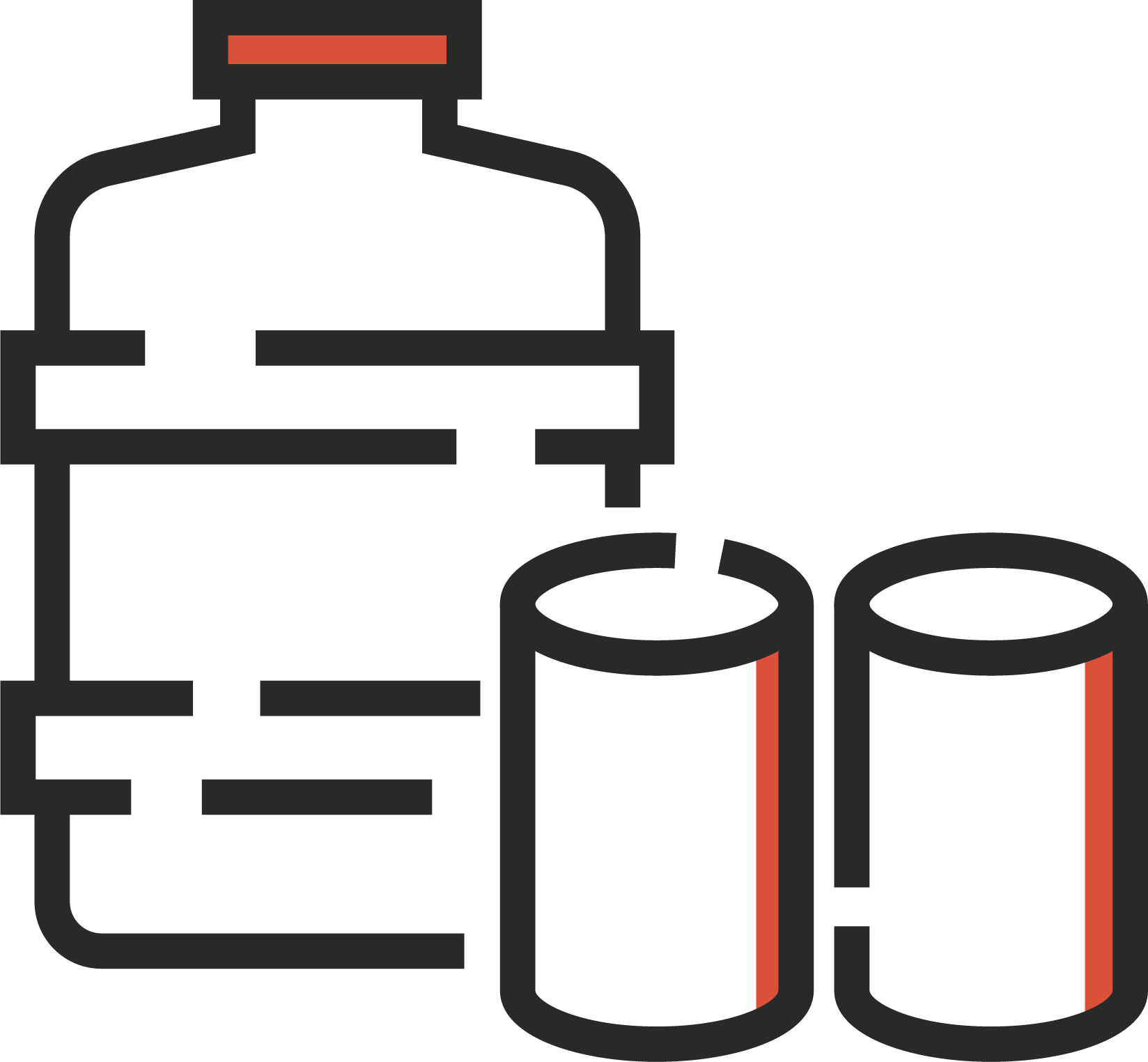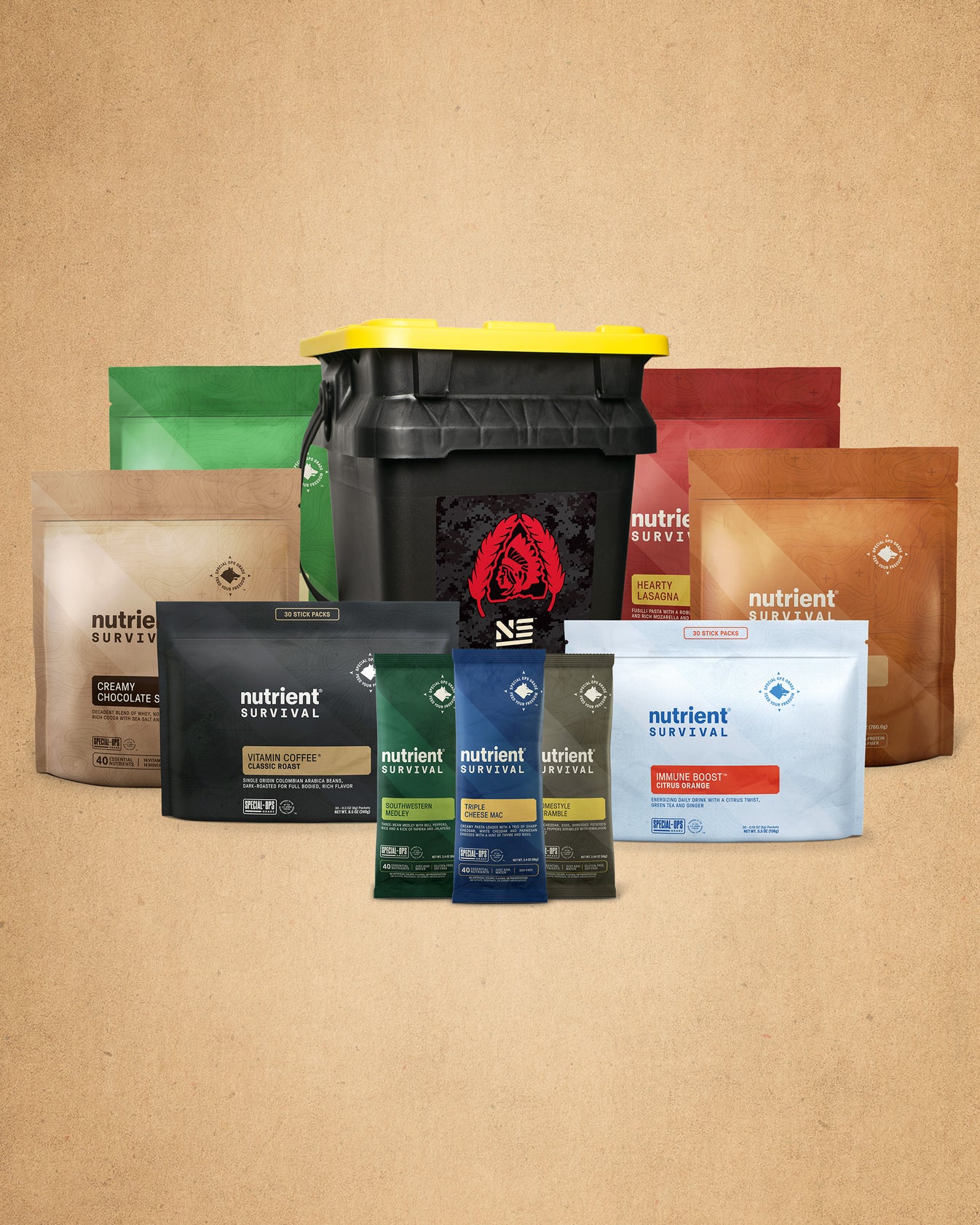Meals Ready to Eat (MRE) are probably something you’re already familiar with. They are the standard issue kits that are given to troops in the field but are also available to the public as emergency meals with an excellent shelf life.
What you may not know is just how many nutrients and calories are packed into an MRE and whether it’s enough to sustain you in the long run. Approximately 38% of the 1,300 total calories in a typical military MRE come from fat, 52% from carbohydrates, and 13% from protein. This amount of energy and nutrients are more than adequate to sustain any survivalist in an emergency or disaster situation.
About 1,200 calories can be found in a standard civilian MRE.
Emergency 72 Hour Food Kit
This essential food kit includes 120 nutrient packed servings. Enough to last you for 14-days at least, or feed your family of 4 for 3 days. Enjoy our top sellers - Triple Cheese Mac, Southwestern Medley, Homestyle Scramble, Hearty Apple Cinnamon Oatmeal, Chocolate Grain Crunch and Powdered...
Consequently, humans could survive on just one MRE per day, albeit they presumably would not thrive, as anyone who’s had an MRE can attest. For a more active lifestyle, particularly that of a soldier, it is recommended that they eat three MREs daily, which can be up to 3,777 calories.
Soldiers’ high-energy expenditure necessitates a hefty caloric intake. One military expert claims that recruits to the Army’s elite Ranger School burn as many as 10,000 calories per day in rigorous physical training.
While you may not be enduring basic training every day, the typical survivalist will still expend more calories than someone lounging on the couch watching Netflix.
Contents
- How Many Calories Does An MRE Have?
- How Many Calories Are In An MRE Meal?
- How Many Calories Are in a Military MRE?
- MRE Vs. Ration
- MRE Nutritional Value
- How Many Calories in A MRE Entree
- What About the Healthiness of MREs?
- A Look At The Dangers To Your Digestive System
- How Many Consecutive Days May MREs Be Consumed?
- How to Consume MREs for Over 21 Days Straight
- Can Constipation Occur After Eating an MRE?
- Can You Gain Weight From Eating MREs?
- Can You Survive Off Only MREs?
- The Date Code on an MRE Is Just as Crucial as the Number of Calories
How Many Calories Does An MRE Have?
Each 1.3-pound MRE contains at least 1,200 calories. Ration packs for 24 hours can include more than 5,500 calories and weigh less than 5 pounds.
Calories per MRE
The average number of calories in an MRE is 1,250.
How Many Calories Are In An MRE Meal?
The U.S. Surgeon General has deemed MRE 3000 calories necessary for optimal health. Each MRE offers a third of the vitamins and minerals. An MRE meal pack has a typical calorie count of 1,250 (13% protein, 36% fat, and 51% carbs).
Beef Ravioli MRE Calories
One packet (227 g) of MRE Beef Ravioli with Meat Sauce contains 280 calories.
Chili Mac MRE Calories
One packet of MRE chili mac contains 380 calories.
How Many Calories Are in a Military MRE?
Soldiers can get up to 3,777 calories daily from three complete MRE meals. Assuming they consume all three meals, a total MRE costs, on average, 1,259. (Breakfast, lunch, and dinner).
Military Meal Ready-to-Eat Nutrition Facts
Getting the right amount of cold weather MRE calories is essential, but maintaining a healthy weight requires more than just counting macros. The typical meal replacement kit includes the following consumables:
- Entree
- Cracker or Bread
- Spread
- Dessert
- Candy
- Beverage
- Seasoning
The entree provides most of the day’s calories, protein, carbs, and dietary fiber. You can observe that using military food as an example; the military version is more in calories:
| Nutritional Content | Military food MRE |
| Calories | 290 |
| Total fat | 11g |
| Saturated fat | 5g |
| Cholesterol | 28mg |
| Sodium | 661mg |
| Total carbs | 31g |
| Dietary fiber | 8g |
| Total sugars | 6g |
| Protein | 20g |
The protein content of the military variant is high, which is beneficial because the body uses protein in many different ways, including repairing damaged cells and tissues and regulating vital body processes.
You should get 10–35 percent of your daily calories from protein, meaning a meal containing 290 calories should have 29–101.5 calories from protein. There should be between 7.25g and 25.38g of protein in this military MRE, assuming four calories per gram of protein. Carbohydrates are essential because they provide your body with their primary energy source; as such, they should account for 45–65 percent of your daily calorie intake.
US Army MRE Calories
The calorie content of more than a hundred distinct military and civilian MRE dinners were analyzed, and the results were strikingly different. These Beef Patties with Jalapeno Peppers have only 140 calories per serving, whereas other options have as many as 480. Finding MREs low in fat and carbohydrates, such as vegan or vegetarian ones, is essential if you plan on eating them but not exercising.
Sopakco’s reduced-sodium MREs are among the least expensive and healthiest options available. Vegetarian options comprise a sizable portion of the MRE offerings, and the average calorie count per meal is lower than that of meat- and fish-based MREs (650-1,060).
The calorie range of military MREs is much narrower. The Combat Rations Database reports that beef stew has 1,195 calories per serving and tuna has 1,389 calories per serving as the lowest and highest calorie options, respectively.
MRE Vs. Ration
A soldier’s food ration is the amount of food they are given daily. A single container usually contains enough food for a whole day. In military parlance, a “ration pack” refers to the food and other supplies a soldier would need for a day’s worth of service. Meal Reconstitution Effort Acronym Meals Ready to Eat (MREs) do not need to be heated or cooled down before consumption.
A soldier’s ration pack may contain either MREs (meals ready to eat) or non-ready-to-eat goods that must be prepared (such as freeze-dried, tinned, or canned food). The ration packs and MREs used by the military have several essential characteristics in common:
- It can be stored for an extended period
Depending on the variety, the shelf life might be anywhere from two years to ten years. It is only necessary to remember where you put them once you need them.
- They pack a lot of calories
Each 1.3-pound MRE contains at least 1,200 calories. Ration packs for 24 hours can include more than 5,500 calories and weigh less than 5 pounds. It is easy to use them. A soldier’s life’s necessities are sealed in one convenient box that is usually airtight and waterproof.
- Survival packs
Ration packets contain food, portable stove-tops, fuel, water purification, matches, toilet paper, vitamins, and hygiene goods like toothbrushes and cleansing wipes.
- The cuisine is superb
Food in international MREs and ration packets is reasonably good if a bit bland. Compared to the Food and Drug Administration’s standards, the European Union’s and NATO’s are much more stringent. All foreign military rations are lightly processed and free of artificial flavors, colors, and additives.
French rations might comprise anything from ostrich to wild boar as well as venison or veal. Squid, octopus, and lamb are all everyday items on Spanish menus. This is real food made with care, so the soldier will want to eat it. Typical regional specialties are highlighted, such as curry (United Kingdom), Polish sausage (Poland), and kasha (Russia).
MRE Nutritional Value
The nutritional needs of soldiers in combat are specifically catered to. Soldiers have a high caloric expenditure. Rations include enough protein, fat, carbohydrates, electrolytes, and short-term performance boosters like chocolate and caffeine to keep soldiers strong.
- As a whole, they are a fantastic buy
Combat rations can appear pricey. However, when you factor in the fact that a family supper out would cost you between $30 and $50. It is the same price for a 24-hour ration pack that can feed a family of five for one meal or maybe all day, and it is easy, healthy, portable, and will not go wrong in the pantry.
How Many Calories in A MRE Entree
One MRE offers a third of the daily value for vitamins and minerals deemed necessary by the United States Surgeon General. On average, the 1,250 calories in a single MRE meal bag come from the carbohydrates, fat, and protein it contains (13% protein, 36% fat, and 51% carbs).
Meal Ready-to-Eat Nutrition Facts
Examining the food label is an excellent first step in determining whether MREs are suitable for survival. Three MREs would provide you with your dietary needs for a day. A very high salt concentration is the MREs’ major flaw. Constipation is another issue due to the lack of fiber and excessive fat content.
| Calories | 1030 |
| Calories from fat | 270 |
| Total fat | 35g |
| Saturated fat | 14g |
| Trans fat | 0g |
| Cholesterol | 85mg |
| Sodium | 194mg |
| Total carbohydrates | 163g |
| Dietary fibers | 3g |
| Sugars | 97g |
| Protein | 45g |
High fat and salt levels are unhealthy for people who spend most of their day sitting. Soldiers that burn a lot of energy in the field can benefit from eating from an MRE. Although MREs are utilized by various military branches and in refugee camps worldwide, you will soon realize that doing so can have significant health effects. When an MRE is opened and consumed by a soldier in the field, natural disaster survivors, people in an emergency, or campers, the contents are swiftly divided up.
The most desirable pieces are consumed or hoarded, while those with intermediate quality are traded, and those with low quality are swiftly and efficiently discarded. For this reason, MREs are not a suitable substitute for the kind of well-rounded diet (combined with strenuous exercise) for which they were initially intended. Many of the greatest MREs are available online, and those that are not can sometimes be found at local army surplus stores.
What About the Healthiness of MREs?
To address whether MREs are nutritious, it is important to dispel some of the urban legends that have persisted about them. The first is that eating nothing but MREs for longer than 21 days can be fatal. Another untruth claims that the MRE’s tabasco sauce and heater may be used to make a weapon. The last one will explain how the gum is a laxative to use after surgery because the MREs are made to make the eater constipated to prevent them from having to go during the operation.
Even if they are fiction, some people might find some truth in them.
A recent study suggests that these illnesses are the exception rather than the rule. Despite soldiers’ efforts to convince the military that MREs routinely cause constipation, this study comes to a slightly different conclusion.
The preceding information should have clarified that MREs are not the healthiest food option, but they can be helpful if nothing else is available. Unlike freeze-dried survival food packages, which have a 25-year shelf life, MREs only have a 3- to 5-year shelf life, so they are not ideal for preppers, but they can help you spice things up if you are getting bored of the same old meals.
MREs, with their balance of calories, proteins, and carbohydrates, are engineered to meet the high-energy demands of survival situations. Considering that a typical military MRE contains approximately 1,250 calories, they are designed to sustain an individual’s energy levels in challenging environments. With the U.S. Department of Defense reporting that soldiers in the field may require up to 4,500 calories daily, MREs provide a compact, durable solution for meeting these nutritional needs, ensuring that individuals can maintain their strength and cognitive function even in the most demanding circumstances.
– Eddie Penney Emergency Prep Expert
A Look At The Dangers To Your Digestive System
Consuming an excessive amount of MREs might lead to significant health issues. To disrupt the equilibrium of the stomach is to disrupt the body’s autoimmune system. Gut health, as defined by the population of beneficial and harmful microbes that call the digestive system home, is essential to overall health, says Medical News Today.
Taking care of one’s gut and ensuring a healthy balance of these bacteria is necessary for many reasons, including one’s emotional and physical well-being and immune system. Therefore, the bacteria in our digestive tracts become unbalanced as soon as we begin feeding the body highly processed, high-fat, high-sodium, and sugar-laden foods like the MRE. Due to this, MREs should only be consumed in conjunction with other freeze-dried emergency food or natural food sources available during a survival crisis.
How Many Consecutive Days May MREs Be Consumed?
In 2015, the U.S. Army solicited civilian volunteers to serve as test subjects for a study on the impact of MREs on intestinal health. They intended to determine what would happen to a person’s gut if they consumed MREs for 21 consecutive days. This is where the misconception that MREs cannot be consumed for longer than 21 days originated.
The military conducts ongoing research on MREs and the implications of consuming them for too long. An article describes what occurred to a citizen who finished MREs for 21 consecutive days. Consuming an MRE diet regularly is not the most enjoyable experience.
The good news is that scientific research now indicates that MREs do not induce as severe constipation as was initially assumed. The study, titled “A diet of U.S. military food rations affects gut microbiota composition and does not increase intestinal permeability,” analyzed the feces, blood, and urine samples of sixty volunteers, both military and civilian.
Half of them only ate MREs twice or three times a day, while the other half ate more conventional meals. Water and black coffee were the only beverages permitted for consumption. They discovered this after waiting three weeks:
It was reported that those who consumed MREs had fewer bowel movements per week than those who had the standard diet. This is because the MRE promotes the growth of bacteria in the stomach that actively hinder the smooth motions humans are accustomed to because of the lack of lactic acid bacteria in fresh foods.
Although the volunteers consumed MREs for longer than the widely held belief that they could survive on them for 20 days (recall the urban legend that 21 days of MREs would be fatal), they did not experience any adverse effects. When participants resumed their regular diet, their bowel movements returned to normal.
How to Consume MREs for Over 21 Days Straight
You may still worry about what would happen if you were trapped in a circumstance where the only food available was MREs. You may take some measures to safeguard your digestive system and avoid constipation.
- Consume dietary vitamin and fiber supplements
Taking additional vitamins and fiber supplements is one of the most straightforward strategies to preserve your digestive tract when consuming MREs. This would only work if you had planned and had a stockpile of fiber supplements for the survival phase.
A decent daily multivitamin will help your body by filling up nutritional gaps that may result from an inadequately diverse diet. Since the shelf life of most multivitamins is at least two years, it is not difficult to keep an extra bottle or two on hand.
- Dilution of the MRE
When it is said, “dilute,” it does not mean literally. Suppose you find yourself in a survival situation. In that case, you can attempt to forage for wild delicacies, such as mushrooms and edible plants, to incorporate more natural elements into your diet. Consider all possible ways to complement the MRE with a natural food source. This will reduce the amount of high-fat and high-protein foods entering the body simultaneously.
- Split It Up
As previously stated, MREs are intended to be consumed in one sitting to provide the most energy to soldiers in the field. However, it is a standard practice to separate the individual food items in an MRE because they are packaged separately.
Can Constipation Occur After Eating an MRE?
Yes and no. Eating only one is safe if you want to try an MRE for kicks but are worried about its effects. Consistent consumption may cause unpleasant side effects. MREs can cause constipation for a few different causes. This is partly because it is low in fiber and contains a lot of fat and sugar but very few calories. Once again, these foods are intended for serving active military personnel in the field during the war and are not suitable for civilian consumption. These elements are designed to be digested slowly, providing the troops with sustained energy during the long, difficult days ahead.
They are designed for one-and-done consumption, rapid digestion, and subsequent application in extremely strenuous physical labor. Since just 53.3% of adults in the United States fulfill the CDC’s Physical Activity Guidelines for aerobic activity, the whole idea of the MRE presents a challenge for the typical person.
Can You Gain Weight From Eating MREs?
Well, that depends. You will put on weight if you consume more calories from the MREs than you expend. Exercising more than you eat on MREs is the only way to prevent weight gain. The military advises that a soldier consume three complete MREs daily, as stated on GoArmy.
In other words, a soldier can consume up to 3,777 calories daily, on average. Soldiers putting on weight is relatively uncommon, and for a good reason. Regular physical training is essential for soldiers to meet the rigorous standards set by the military. Rucking is also a standard military workout.
Ruck marches require soldiers to carry heavy equipment over long distances. Therefore, it is reasonable to assume that soldiers readily burn off the calories they consume from MREs. As for civilians, there is a high probability of weight gain from MREs if you eat three full civilian MRE meals, which can add up to an average of 3,738 calories without exercising to burn off the calories.
It’s important to remember that in addition to your MRE intake and other factors, your body’s genetics, metabolism (how well your body burns off energy/calories), physical activities, current weight, and many other factors all have a role in whether or not you gain fat from MREs.
Can You Survive Off Only MREs?
As shocking as it may sound, the answer to the big question of whether or not you can survive on MREs is no. Consequences, including death, are possible when the digestive system is affected. You should complement your emergency food supply with MREs but not rely solely on them. What to anticipate if you exist on MREs
- Going to the restroom quite often
- Having little vitality
- Overstuffed and uncomfortable
- Confused in one’s thoughts
Instead of MREs, there are several varieties of emergency food kits or “survival food” that you can purchase to help avoid surviving solely off MREs:
The Date Code on an MRE Is Just as Crucial as the Number of Calories
The date on an MRE indicates how long it will stay fresh. Because many con artists are peddling stale military MREs on sites like eBay and others, we feel it necessary to stress the significance of checking the expiration dates. A four-digit code is printed on the back of each MRE’s packaging, and you can use this information in an online date code calculator to determine when the meal was produced.
Conclusion
The MRE program aims to supply military soldiers with a convenient, portable meal containing all the necessary nutrients. Therefore, they often all have the exact calorie count, around 1250 on average per serving.
The meals included in civilian MREs are substantially less uniform. Menu items range from around 150 calories to nearly 500. In the same vein, some full meals include as few as 650 calories, while others have as many as 2,400! Food stored in an MRE is not great for your body or wallet, but it will keep you going for 21 days in the wilderness.




























